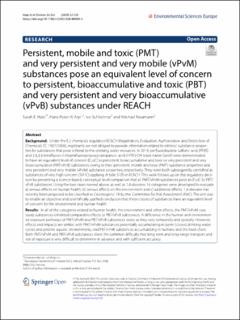Persistent, mobile and toxic (PMT) and very persistent and very mobile (vPvM) substances pose an equivalent level of concern to persistent, bioaccumulative and toxic (PBT) and very persistent and very bioaccumulative (vPvB) substances under REACH
Peer reviewed, Journal article
Published version
Permanent lenke
https://hdl.handle.net/11250/2756119Utgivelsesdato
2020Metadata
Vis full innførselSamlinger
- NGI articles [1037]
Sammendrag
Under the EU chemicals regulation REACH (Registration, Evaluation, Authorisation and Restriction of Chemicals EC 1907/2006), registrants are not obliged to provide information related to intrinsic substance properties for substances that pose a threat to the drinking water resources. In 2019, perfluorobutane sulfonic acid (PFBS) and 2,3,3,3-tetrafluoro-2-(heptafluoropropoxy)-propanoic acid (HFPO-DA trade name GenX) were demonstrated to have an equivalent level of concern (ELoC) to persistent, bioaccumulative and toxic or very persistent and very bioaccumulative (PBT/vPvB) substances owing to their persistent, mobile and toxic (PMT) substance properties and very persistent and very mobile (vPvM) substance properties, respectively. They were both subsequently identified as substances of very high concern (SVHC) applying Article 57(f ) in REACH. This work follows up on this regulatory decision by presenting a science based, conceptual level comparison that all PMT/vPvM substances pose an ELoC to PBT/ vPvB substances. Using the two cases named above, as well as 1,4-dioxane, 16 categories were developed to evaluate a) serious effects on human health, b) serious effects on the environment and c) additional effects. 1,4-dioxane has recently been proposed to be classified as Carcinogenic 1B by the Committee for Risk Assessment (RAC). The aim was to enable an objective and scientifically justified conclusion that these classes of substances have an equivalent level of concern for the environment and human health.
